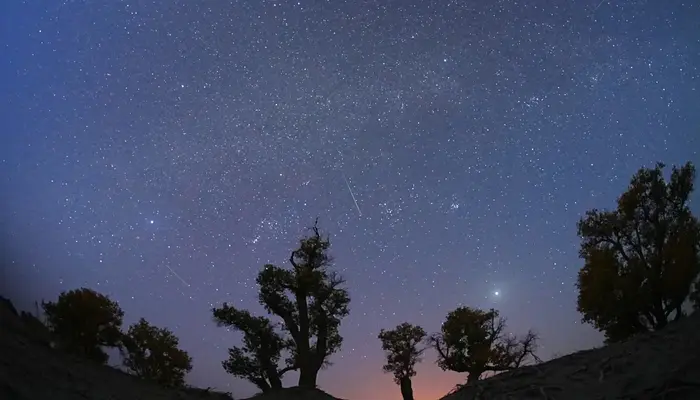Halley’s Comet Debris Sparks Orionid Meteor Shower This Week

The famous Halley’s Comet, currently halfway through its 76-year orbit around the sun, won’t be visible until 2061. However, its debris is lighting up Earth’s night sky in the form of the Orionid meteor shower.
The Orionids will peak Sunday night into Monday, offering a stunning celestial display. Sky-gazers can expect to see around 10 to 20 meteors per hour during this time, according to the American Meteor Society. The best viewing time is after midnight when the constellation Orion, the meteor shower’s radiant, is high in the sky.
This meteor shower will be visible from all parts of the world, except Antarctica, where the sun does not set at this time of year, said Robert Lunsford, fireball report coordinator for the American Meteor Society.
Even a few days after the peak, the Orionids will still produce a significant number of meteors. “The Orionids have a flat peak, so if you miss the peak night due to cloudy skies, you’ll still see plenty of activity the night after,” Lunsford explained.
Later in October, the full moon, known as the Hunter’s Moon, will wane, making it easier to observe meteors without interference from bright moonlight. Lunsford recommends looking away from the moon for better visibility of the faint meteors.
What Are Orionids?
The Orionid meteor shower occurs as Earth passes through the debris trail left by Halley’s Comet. This happens twice a year: first in May with the Eta Aquariids and then in October with the Orionids.
As the comet’s particles hit Earth’s atmosphere, they burn up and create bright meteors, known as fireballs if they’re especially large. These fireballs can be brighter than Venus, according to NASA.
How to Watch the Meteor Shower
For the best viewing experience, NASA suggests spending 30 minutes outside beforehand to allow your eyes to adjust to the darkness. The higher the altitude, the clearer the sky will be, and the less moonlight will scatter.
The Orionids will remain active until November 22, so there’s plenty of time to enjoy this celestial show. Lunsford believes the beauty of meteor showers lies in their unpredictability, saying, “No one night is the same — everything has moved a little bit — and no year is the same.”
More Celestial Events in 2024
The Orionid meteor shower kicks off an exciting season of meteor showers to close out 2024. Here are some upcoming peak dates for celestial activity, according to the American Meteor Society:
- Southern Taurids: November 4-5
- Northern Taurids: November 11-12
- Leonids: November 17-18
- Geminids: December 13-14
- Ursids: December 21-22
There are also two full moons left for 2024: the Beaver Moon, which is a supermoon, on November 15, and the Cold Moon on December 15, according to the Farmers’ Almanac.
Follow us on Google News, Instagram, YouTube, Facebook,Whats App, and TikTok for latest updates












